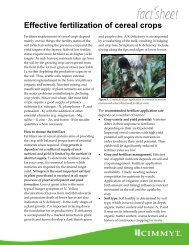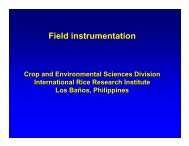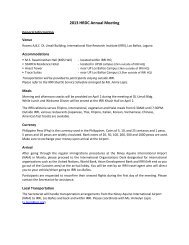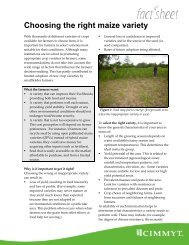Water management in irrigated rice - Rice Knowledge Bank ...
Water management in irrigated rice - Rice Knowledge Bank ...
Water management in irrigated rice - Rice Knowledge Bank ...
- No tags were found...
Create successful ePaper yourself
Turn your PDF publications into a flip-book with our unique Google optimized e-Paper software.
level: the irrigation system, prov<strong>in</strong>cial, or nationallevel. Farmers must face the consequences of thesedecisions: they receive less water and have to copewith “imposed water scarcity.” The notion that weshould ask farmers to actively save water so it canbe used elsewhere, such as by <strong>in</strong>dustry and cities,is a fallacy. Farmers can be encouraged to voluntarilyreduce water use, for example, by <strong>in</strong>troduc<strong>in</strong>gvolumetric water pric<strong>in</strong>g, but this is the exceptionrather than the rule and “enforced water scarcity” isprevalent. Voluntary water sav<strong>in</strong>gs by farmers forredirected use work well only with properly function<strong>in</strong>gwater markets. For example, <strong>in</strong> Australia,<strong>rice</strong> farmers <strong>in</strong> irrigation schemes <strong>in</strong> the Murraybas<strong>in</strong> can sell their water rights <strong>in</strong> a water market toother users, such as other farmers who grow highvaluecrops such as fruits (Thompson 2002).Def<strong>in</strong>ition 2: to reduce expenditures becauseof reduced <strong>in</strong>come. In water terms, this translates<strong>in</strong>to “reduc<strong>in</strong>g the use of irrigation water becausethere is less of it.” This type of water sav<strong>in</strong>gs <strong>in</strong>agriculture is <strong>in</strong>duced by actual and physical waterscarcity. An example of this situation for farmersis the “enforced water shortage” discussed above.However, an absolute water shortage can also be<strong>in</strong>duced by natural causes. For example, when seasonalra<strong>in</strong>s have failed to fill up reservoirs or ponds,the amount of water may not be sufficient to keepall <strong>rice</strong> fields flooded throughout the year. Whenthe reservoir forms part of a large-scale irrigationsystem, reservoir managers usually respond byreduc<strong>in</strong>g the “program area” for irrigation: fewerfarmers will receive irrigation water. However, withsmaller reservoirs such as <strong>in</strong>dividual ponds, farmersthemselves can decide how to cope with the waterscarcity. They may decide to reduce their land underirrigation or they could decide to “reduce currentexpenditures to allow for future expenditures”: todeliberately save water early <strong>in</strong> the season to have itavailable later <strong>in</strong> the season. Farmers can save waterby reduc<strong>in</strong>g the amount of irrigation applied to theirfields early <strong>in</strong> the season. The best way to do this isby reduc<strong>in</strong>g the nonproductive outflows seepage,percolation, and evaporation (Chapter 3).Def<strong>in</strong>ition 3: to reduce costs to <strong>in</strong>crease profit.In water terms, this translates <strong>in</strong>to “reduc<strong>in</strong>g theuse of irrigation water to lower the costs.” Thisscenario is applicable when farmers pay a high costfor water and have the means to reduce their wateruse to <strong>in</strong>crease their profits. There may be plentyof water, but it is relatively expensive (“economicwater scarcity”). In most surface irrigation systems<strong>in</strong> Asia, farmers either pay no cost for their water orpay a flat rate (a fixed sum per unit land area), andwater costs cannot be reduced by reduc<strong>in</strong>g wateruse. When farmers pump their own water, either<strong>in</strong>dividually or collectively, they pay a relativelyhigh p<strong>rice</strong> for their water when pump<strong>in</strong>g is fromdeep aquifers and/or when the p<strong>rice</strong> for electricityor fuel is high. In this case, water sav<strong>in</strong>gs byfarmers are a voluntary and deliberate choice oftheir own. The means to save water are the sameas <strong>in</strong> the scenario above: to reduce irrigation waterto their fields.These examples illustrate that water scarcity isusually imposed upon farmers (either by nature orby decision makers at higher levels) and that sav<strong>in</strong>gwater is hardly a voluntary choice (except <strong>in</strong> def<strong>in</strong>ition3). Farmers just have to cope with physicalwater scarcity, and the term “water-scarcity cop<strong>in</strong>gtechnology” may be more appropriate than the term“water-sav<strong>in</strong>g technology.”10





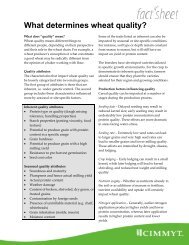

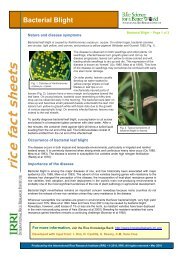

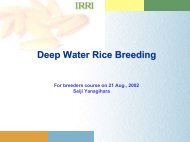
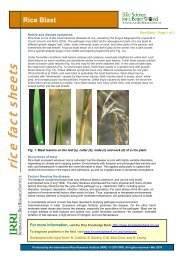
![International Standards' Organization â Rice Specification [ISO 7301]](https://img.yumpu.com/36696862/1/190x245/international-standards-organization-a-rice-specification-iso-7301.jpg?quality=85)

